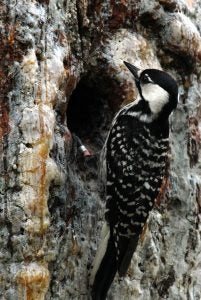
The red-cockaded woodpecker is a keystone species of the longleaf pine ecosystem. (Photo credit: U.S. Fish and Wildlife Service Southeast Region)
In the pine forests of the Southeast, a small black and white bird spends its days hammering out cavities in the trunks of mature longleaf pine trees. The red-cockaded woodpecker is endangered, and its status reflects the condition of the entire forest ecosystem upon which it depends.
It was the gradual but steady disappearance of the region’s unique longleaf pine forests due to increased settlement, timber harvesting and development that initially raised concerns about the decline of the red-cockaded woodpecker population in the 1960s.
Since then, collaborative efforts between the federal government and private landowners initiated an encouraging uphill comeback for the keystone species.
The woodpecker’s descent
Red-cockaded woodpeckers rely on mature pine forests – the birds roost and nest in trees up to and beyond 100 years old. This habitat was altered over time due to timber and agriculture industry expansion in the Southeast, in addition to impacts from increasing human development, which led to sharp declines in bird populations.

Red-cockaded woodpeckers create cavities that are used by a number of other species including bluebirds, other species of woodpeckers, owls, squirrels and insects. (Photo credit: U.S. Fish and Wildlife Service Headquarters)
Overall, longleaf pine forests dropped from approximately 92 million acres a century ago to fewer than 3 million acres today.
This dramatic 97 percent loss of habitat was the single biggest threat to the bird, which dropped from historical population estimates of approximately 1-1.6 million groups (a family unit of woodpeckers) to an estimated 10,000 individuals remaining today, scattered among 4,000 groups.
In addition to habitat loss, fire suppression caused significant changes in tree species composition and forest structure. Over time, open old-growth longleaf pine savannas used by the woodpecker were transformed into mixed pine and hardwood forests that attracted competitors and predators.
Uncommon partners unite
To change things around for the red-cockaded woodpecker, biologists, foresters, policymakers, military bases and private landowners united with inspiring force and effectiveness.
The joint effort can be traced back as far as 1967, when the red-cockaded woodpecker was added to the very first endangered species list. The listing prompted changes in forest management on federal lands, including National Forests and several military installations, such as the Army’s conservation effort at Fort Bragg. On these federally managed lands, improved practices were adopted to allow large pine trees to grow. These practices included planned fires to control the hardwood understory and keep the forests from getting too dense.

Safe harbor agreements are widely used today to encourage private landowners to protect vulnerable wildlife on their property without incurring regulatory restrictions. (Photo credit: U.S. Department of Agriculture)
On private lands, EDF worked with the U.S. Fish and Wildlife Service in the 1990s to establish the first-ever safe harbor agreements for the red-cockaded woodpecker on private lands around Fort Bragg. A key partner in this effort was the North Carolina Pine Needle Producers Association, a group of small businessmen who, like the red-cockaded woodpecker itself, benefitted from maintaining large tracts of older longleaf pine forest.
Together, these public-private partnerships created a new model of collaborative conservation that has been used to protect other at-risk wildlife, from the golden-cheeked warbler to the black-footed ferret.
Today, the red-cockaded woodpecker population is increasing thanks to a combination of strong science, improved management, effective laws, and the steadfast dedication of many diverse partners who all laid a welcome mat on their lands to protect the bird and its precious forests.
Michael Bean started working at EDF in 1977 directing wildlife conservation policy initiatives. In 2009, Michael joined the U.S. Department of the Interior as counselor to the Assistant Secretary for Fish, Wildlife and Parks, and later as the Principal Deputy Assistant Secretary. Today, Michael is back as an advisor to EDF.
Related:
The secret survival of the “masked bandit” in the American prairie>>
How the fastest American raptor nearly nosedived into extinction>>
Operation Warbler: Fort Hood and local ranchers team up to save bird>>










One Comment
Thank you for telling a bit the RCWs’ story (plight!). In Virginia, we had just one breeding population (of just 50 +/- individual RCWs) left. I have been volunteering with a three-year (2015-2017) translocation project to recreate a second breeding population of RCWs in Virginia. The second breeding population is located in the Great Dismal Swamp Wildlife Refuge. This spring, the RCWs translocated to the Dismal Swamp had babies! We are very hopeful and eager for next spring! http://www.wm.edu/news/stories/2015/ornithological-ninjas-infiltrate-the-woods-on-behalf-of-endangered-woodpeckers.php